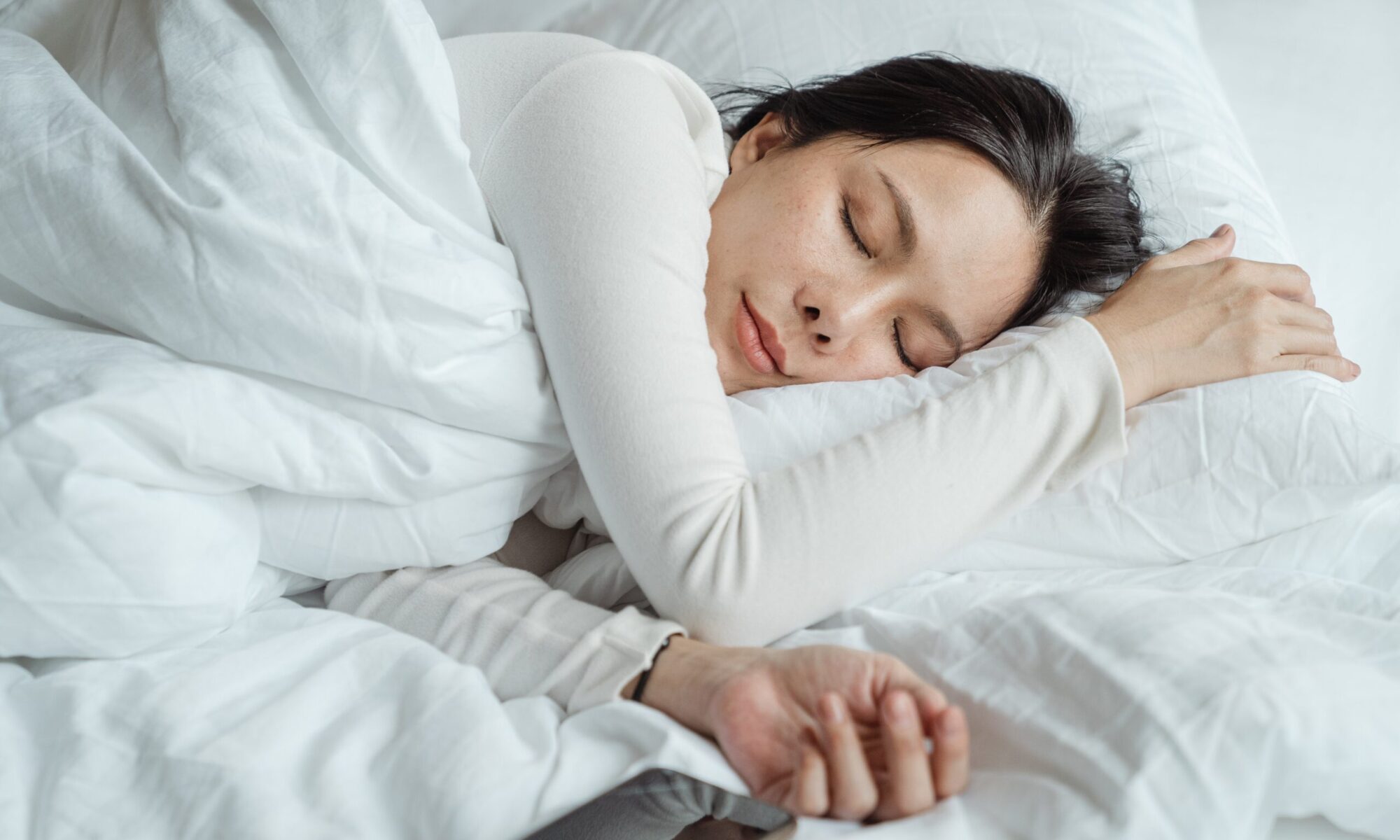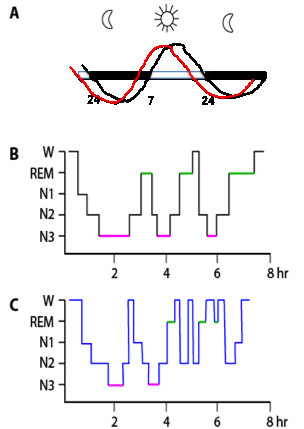During sleep, the sleeper should cycle between REM and non-REM sleep. REM stands for rapid eye movement because during this stage of sleep the eyes move rapidly which doesn’t happen in non-REM (NREM) sleep.
Rapid eye movements
Recent studies published in the journal ‘Brain’ suggests that our eyes may shift their gaze to focus on the people and places present in our dreams during REM sleep. In the study they matched movement of the body with movement of the eyes and found that 90 percent of the time action and gaze were synchronized.
When you fall asleep, you enter non-REM sleep, stages 1-3, followed by a shorter period of REM sleep and then the ” sleep cycle” starts over again. There are about 5 (90 minute) cycles per ‘nightly ‘sleep’.
The average length of the first NREM-REM sleep cycle is between 70 and 100 minutes; the average length of the second and later cycles is about 90 to 120 minutes. The reason for such a specific cycling pattern of NREM and REM sleep across the night remains unknown.
The sleep cycle.
There are three phases of non-REM sleep. So, each stage can last from 5 to 15 minutes. Each phase takes you to a deeper level of sleep (unless this deepening is disturbed – as in obstructive sleep apnea or noise). There are these three phases before reaching REM sleep, stage 1-3. There used to be a fourth but that has now been combined with stage 3.
In stage 1, the eyes are generally closed, but it’s easy to wake if there is an outside stimulus. This stage may last for 5 to 10 minutes.
In stage 2, there is light sleep. The heart rate slows and body temperature drops in readiness for deeper sleep.
Stages 3 is the deep sleep stage. It’s harder to awaken during this stage, and if someone woke you up, you would feel disoriented for a few moments.
During the deep stages of NREM sleep, the body repairs and regrows tissues, builds bone and muscle, and strengthens the immune system, this is therefore referred to as restorative sleep.
With aging, most people sleep more lightly and need less deep sleep. Ageing is also linked to shorter time spans of overall sleep, although some studies show you still need as much sleep as when you were younger.
What Is REM Sleep?
Usually, REM sleep occurs 90 minutes into each sleep cycle (90 minutes). The first REM episode typically lasts 10 minutes and each subsequent REM stages gets longer, and the final one may last up to an hour.
This is of significance in obstructive sleep apnea. Heart rate and breathing quickens during REM sleep.
While there still remains some controversy, it is generally agreed that dreams are more likely during REM sleep. REM sleep has been referred to as ‘paradoxical sleep’ as paradoxically it’s the most closely appearing to wake when measured.

What Happens During Non-REM Sleep?
REM sleep is especially fascinating because it increases brain activity, promotes learning, and creates dreams. You could, ‘roughly’ consider REM as promoting brain refreshment where NREM would be body refreshment.
Research shows that a chronic lack of sleep, or getting poor quality sleep, increases the risk of disorders including high blood pressure, cardiovascular disease, diabetes, depression, and obesity. Studies with mice have shown dramatic shortening of life expectancy when REM sleep is removed from the sleep cycle.
REM appears to have specific functions REM sleep is understood to be a critical component of sleep in all mammals, including humans. Poor sleep-quality is increasingly associated with the onset of various brain disorders such as Alzheimer’s and Parkinson’s disease.
In the disease REM behaviour disorder (RBD), dreams can be acted out during REM sleep when normally there would be paralysis of skeletal muscle. Not only does this endanger the suffer from harm during the dream but the bedpartner too.
Unfortunately, there is a strong association between RBD and the development of Parkinson’s disease.
REM sleep is often significantly disturbed in Alzheimer’s diseases (AD), and results from this study suggest that disruption of REM sleep may contribute directly to memory impairments observed in AD.
To test the long-term spatial memory of mice and the effect of REM sleep/deprivation, , researchers trained the mice to spot a new object placed in a controlled environment where two objects of similar shape and volume stand.
Spontaneously, mice spent more time exploring the novel object than a familiar one, showing their use of learning and recall. When these mice were in REM sleep, however, the researchers used light pulses to turn off their memory-associated neurons to determine if it affects their memory consolidation. In effect removing REM sleep.
The next day, the same rodents did not succeed the spatial memory task learned on the previous day. Compared to the control group, their memory seemed erased, or at least impaired.
Silencing the same neurons for similar durations outside REM episodes had no effect on memory. This seems to indicate that neuronal activity specifically during REM sleep is required for normal memory consolidation.
Memory consolidation may be primarily associated with REM sleep but it is generally believed that overall, it most likely requires both non-REM sleep also.
As the brain is active, dreaming may be more intense. While most dreaming occurs during REM sleep, (although some can also occur in non-REM sleep), unlike in NREM, muscles and leg muscles become temporarily paralyzed, which prevents you from acting out your dreams.
The exceptions in REM sleep are heart, (circulation), diaphragm (breathing) and the eyes, related to brain function. As you age, you sleep less of your time in REM sleep.

Babies can spend up to 50% of their sleep in the REM stage, compared to only about 20% for adults. This is believed to be related to a baby/toddler/infant child’s increased neural plasticity – the state during which more neural connections can be made
Sleep is an important part of your daily routine—you spend about one-third of your time doing it. Quality sleep – and getting enough of it at the right times — is as essential to survival as food and water. Without sleep you can’t form or maintain the pathways in your brain that let you learn and create new memories, and it’s harder to concentrate and respond quickly.
Sleep is important to a number of brain functions, including how nerve cells (neurons) communicate with each other. In fact, your brain and body stay remarkably active while you sleep. Recent findings suggest that sleep plays a housekeeping role that removes toxins in your brain that build up while you are awake.
During episodes of obstructive sleep apnea breathing cessation, the sleep cycle is broken as the sufferer awakes to break the effect of suffocation. These episodes are more common in REM sleep due to muscle paralysis, which increases airway closure and compromise.
Since REM sleep duration lengthens as the night progresses, these OSA episodes mirror this. Consequently, the stress following airway closure increases, and the dangers associated increase too.

Consequently, the most common times to have a heart attack are either late afternoon after work or between midnight and 6am.
The removal of a CPAP machine after midnight is therefore to be avoided. Unfortunately, many people simply can’t wear theirs all night and that would be the time it’s pulled off.
There may be an argument for the use of an oral appliance in these cases as they often achieve a similar result but with significantly more compliance.
REM sleep remains an intriguing but clearly crucial part of sleep.

